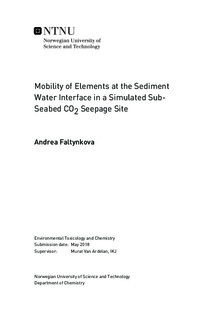Mobility of Elements at the Sediment Water Interface in a Simulated Sub-Seabed CO2 Seepage Site
Master thesis
Permanent lenke
http://hdl.handle.net/11250/2503395Utgivelsesdato
2018Metadata
Vis full innførselSamlinger
- Institutt for kjemi [1394]
Sammendrag
Carbon capture and storage (CCS) is an important technology for the mitigation of global warming. However, prior research has indicated that CO2 escape through marine sediment can lead to the acidification of sediment pore water and the water column leading to the dissolution of a variety of elements. Flux of elements from the sediment to the water column may have negative effects on biota and alter element cycling. Using a mesocosm laboratory study, this research aims to mimic conditions in the Baltic sea region to evaluate changes in geochemical cycling in the event of an acidification event due to CO2 seepage. Operating at relevant hydrostatic pressures, Baltic sea sediments were used in combination with chemically adjusted water from Trondheimsfjord to mimic Baltic conditions. Limecola balthica and Hediste diversicolor were added to the sediment to consider their impacts on geochemical cycling, but also asses the toxicological effects of CO2 seepage. A BCR sequential extraction protocol was used to analyze four fractions of sediment. It was determined that all fractions of sediment are impacted by CO2 seepage, though not in a consistent pattern. Due to experimental complications, only element fluxes from sediments containing Limecola balthica were considered. Most notably, As and Fe in the labile fraction were mobilized, while Fe and Mn increased in the reducible fraction indicating the persistence of Fe and Mn (hydr)oxides. Even the residual fraction of sediment showed signs of mobilization of elements. It was shown that at pH = 7, cations released from Fe and Mn hydr(oxides) can be complexed by organic matter, potentially preventing flux into the water column. The data obtained from this study can be used to inform geochemical models and asses the risk posed by CCS in the Baltic Sea.
